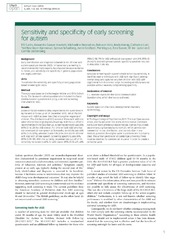Sensitivity and specificity of early screening for autism
Suren, Pål; Havdahl, Alexandra; Bresnahan, Michaeline; Hirtz, Deborah; Hornig, Mady; Lord, Catherine; Reichborn-Kjennerud, Ted; Schjølberg, Synnve; Øyen, Anne-Siri; Magnus, Per; Susser, Ezra; Lipkin, W. Ian; Stoltenberg, Camilla
Peer reviewed, Journal article
Published version

Åpne
Permanent lenke
https://hdl.handle.net/1956/20689Utgivelsesdato
2019Metadata
Vis full innførselSamlinger
Sammendrag
Background: Early identification and diagnosis is beneficial for children with autism spectrum disorder (ASD). Universal early screening is recommended by many experts, but disputed because evidence is limited, and sensitivity and specificity in general populations are largely unknown. Aims: To estimate the sensitivity and specificity of early population-based screening for ASDs. Method: The study was based on the Norwegian Mother and Child Cohort Study. The 36-month cohort questionnaire included the Social Communication Questionnaire (SCQ), a 40-item screening instrument for ASD. Results: A total of 58 520 mothers (58%) responded to the questionnaire. By the end of follow-up on 31 December 2015, 385 (0.7%) individuals with ASD had been identified among the responders' children. The distributions of SCQ scores in those with ASD and other children had large degrees of overlap. With the cut-off of 15 recommended in the SCQ manual, screening sensitivity was 20% (95% CI 16–24) for ASD overall. For children with ASD who had not developed phrase speech at 36 months, sensitivity was 46% (95% CI 35–57%), whereas it was 13% (95% CI 9–17) for children with ASD with phrase speech. Screening specificity was 99% (95% CI 99–99). With the currently recommended cut-off of 11, sensitivity increased to 42% for ASD overall (95% CI 37–47), 69% (95% CI 58–79) for ASD without phrase speech and 34% (95% CI 29–40) for ASD with phrase speech. Specificity was then reduced to 89% (95% CI 89–90). Conclusions: Early ASD screening with a parent checklist had low sensitivity. It identified mainly individuals with ASD with significant developmental delay and captured very few children with ASD with cognitive skills in the normal range. Increasing sensitivity was not possible without severely compromising specificity.
